How to maintain automated poultry farming equipment
Automatic poultry farming equipment plays a very important role in the modern breeding industry. They are also widely used by farmers. It is very necessary to do a good job of maintenance during the use of breeding equipment, so that they can work better. Effective maintenance and maintenance can extend the use time of the equipment, so how should we pay attention to maintenance during use?
The content of maintenance and maintenance of automated chicken breeding equipment generally includes daily maintenance, regular maintenance, regular inspection and precision inspection. In addition, for some exciting equipment, equipment lubrication and cooling system maintenance is also an important part of maintenance. Generally speaking, daily maintenance is the basis of equipment maintenance work. Therefore, farmers need to be standardized and institutionalized to maintain and manage.

Periodic inspection is a planned, targeted and preventive inspection. In addition to the human senses, the inspection means must also have certain inspection tools and instruments. Farmers should observe and inspect the operation of chicken battery cages, automatic feeding systems, automatic drinking water systems, automatic ventilation systems, and automatic manure removal systems on a regular basis.
The maintenance of breeding equipment needs to be carried out on a regular basis, so that the operating conditions of the equipment can be grasped in real time, and problems and failures can be discovered in time and solved immediately. We usually maintain effective maintenance at any time during use, so as to effectively extend the service life of the equipment and save time and effort.
Why do many people choose automatic feeding equipment for chicken farms
In the process of raising chickens, in addition to providing a good environment for the chickens, raising is also a very important point. Nowadays, farmers who use poultry layer cages to raise chickens to feed chickens must pay more attention to the feeding of feed. Automated feeders can help major farmers to raise chickens effectively, which not only saves space for discipline inspection commissions, but also effectively solves manpower.
The priority equipment for breeders to improve labor efficiency is the driving feeder. This equipment becomes a good assistant for the breeder’s supply work. It can solve the problems of uneven manual supply and insufficient supply of upper chickens, effectively improve the breeder’s work efficiency and reduce feed. Waste, indirectly reduces the economic input of the chicken farm in feed.

The traveling feeder has simple structure, convenient maintenance, cost saving and high efficiency. The walking system adopts chain and sprocket transmission, which has good shock-proof effect and corrosion resistance. The guide rail is laid with square steel, which can stably walk, increase the contact area, anti-skid, and save electricity. The company’s automatic supply system can deliver feed to poultry steadily and without separation, ensuring that each hen feeds every day. It is matched with the high edge trough to save feed and does not spread. At the same time, it has high operating efficiency, high maintenance requirements and long service life. long.
In order to have to use the automatic feeder system, farmers should pay attention to keeping enough space around the drive during use, so that ventilation and adjustment become easy. Keep the drive away from dust and high humidity environments and avoid accidental contact. Keep away from other heat sources when fixing the drive. Ensure that the drive is working within the specified ambient temperature range. Avoid installing on equipment with excessive vibration. If installation is required, good anti-vibration measures should be taken.
The above is the shared advantage of using automatic chicken raising equipment-automatic feeder. Hope the above sharing can help farmers.
To raise chickens, you need to know the advantages of cages
Layer equipment breeding chicken cages mainly include stacked layer cages and stepped layer cages. Both cages have their own advantages in the breeding process. When making purchases, farmers can determine which cage they choose for breeding according to their budgeted breeding costs, as well as the area of chicken coops built and the number of breeding. In order to enable farmers to purchase cages more conveniently and quickly, today's laying hen equipment suppliers will introduce to farmers the advantages of the two cages in breeding.
Advantages of layer cage breeding with stacked layer equipment:
- The separation net and bottom net of the layer cage are encrypted, which can effectively prevent the pecking of the anus and the fatigue syndrome of the laying hen.
- The mesh of the layer cage is galvanized, which can increase the service life of the cage. Generally, it can be used for more than 10 years.
- The unique door reinforcement design of the layer cage can effectively prevent the chickens from shaking and wasting feed when they eat. And because the cage door space is increased, it is more convenient to manage various chickens.
- The mesh of the layer cage is relatively smooth, which can prevent the chicken from being injured and infected with the foot.
- High-density breeding in layer cages saves land, is conducive to epidemic prevention, and can also reduce the incidence of chicken diseases.

Ladder layer equipment layer cage breeding advantages:
- The laying hens can obtain more breeding area and increase the laying rate of the laying hens.
- Compared with the stacked cage system, the investment can be reduced.
- The ventilation effect is good to ensure that the laying hens in the cage system will not suffocate due to high temperature.
- Convenient disinfection, easy to control coccidiosis and other parasitic diseases and worm infections.
- The automatic drinking water system can ensure equal water pressure in the nipple and ensure the drinking of the laying hens.
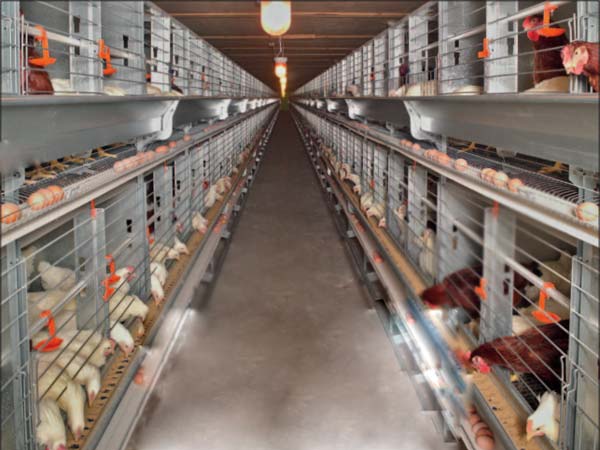
The above are the advantages of the two different poultry layer breeding cages summarized by the laying hen equipment supplier to the farmers. When purchasing the cage, the farmers can follow the characteristics mentioned by our laying hen equipment supplier today. Come choose the cage that suits your breeding needs, I hope it will be helpful to you.
The most common automated poultry farming equipment in chicken farms
Automatic poultry farming equipment are a kind of unmanned, intelligent and automated chicken breeding equipment. The use of fully automated chicken farms by farmers can reduce the labor cost of raising chickens and realize more efficient chicken raising. They are great hands for large-scale farming by farmers. Here is an introduction to the most commonly used fully automatic chicken raising equipment in chicken farms.
It is best to buy the Q235 craft for the chicken coop, because it is strong and durable and not easy to bend. Hot-dip galvanized chicken cages have a long service life. Chicken cages are divided into layer cages, broiler cages, and brooding chickens. Choose different types of chicken cages according to different types of chickens, which is more conducive to the growth of chickens.
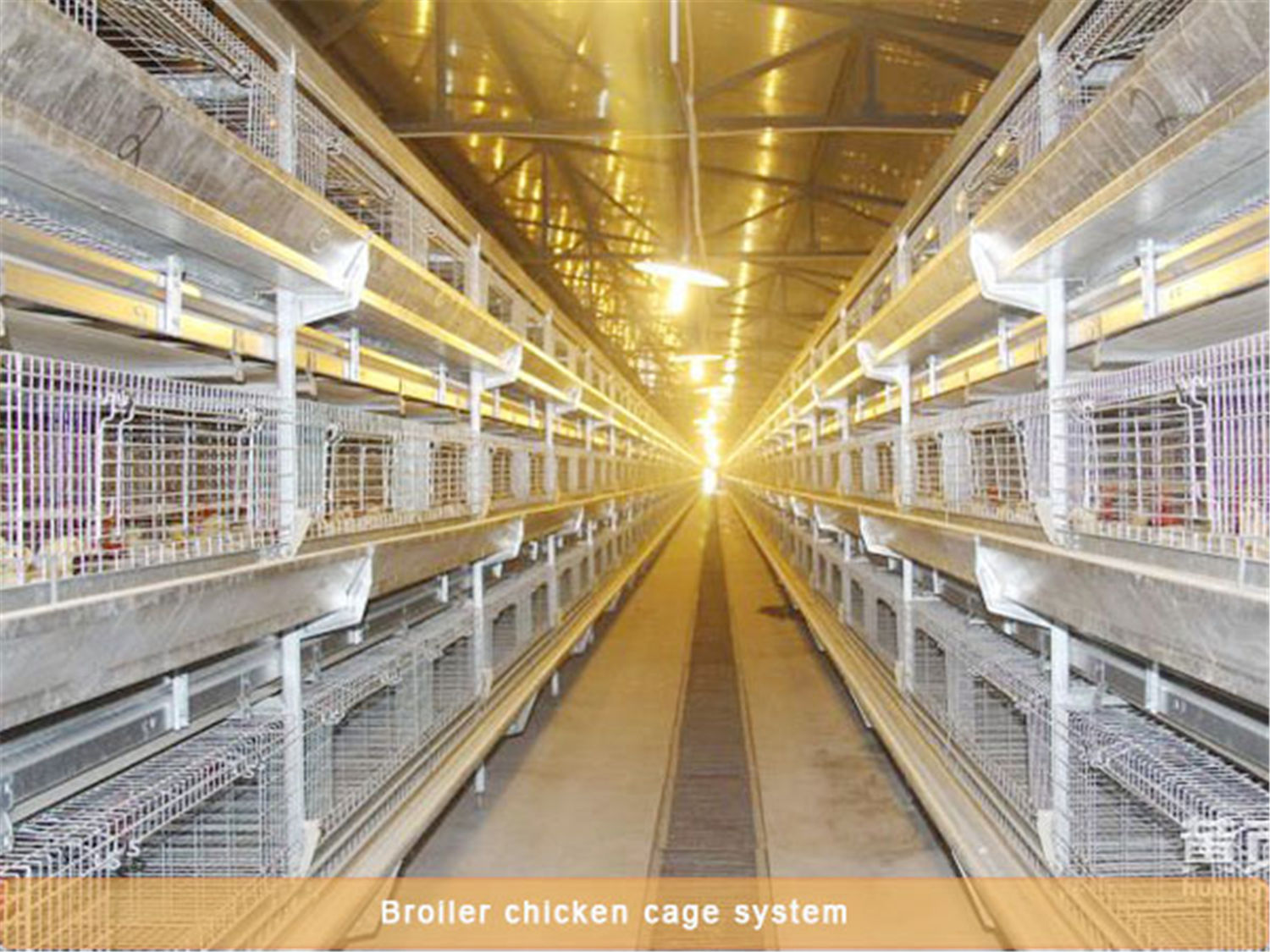
Egg collection machine
Automatic egg collection and horizontal egg collection products, scientific and reasonable structure, sturdy and durable, easy to operate, save time and effort, just press the button to complete the egg collection operation, the egg collection is smooth, the egg collection is fast, the egg damage rate is low and efficient Stable, greatly improve breeding efficiency, reduce labor input, and reduce breeding costs. It is an ideal equipment for upgrading layer breeding industry.
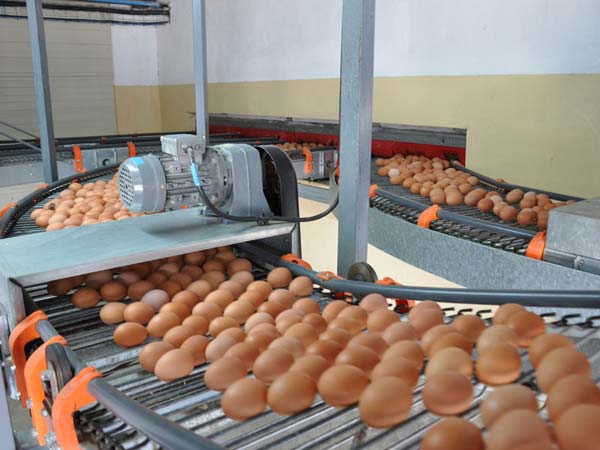
Automatic drinking water equipment
Water lines are reasonably installed on both sides of the chicken coop for the chickens to drink. Under the whole water pipeline, there are multiple nipple drinkers and water receiving trays. When the chickens drink water, they will drip out when they lightly touch the nipple. Because the water is not exposed to the outside, it is better to ensure that the chickens can drink clean and pollution-free drinking water.
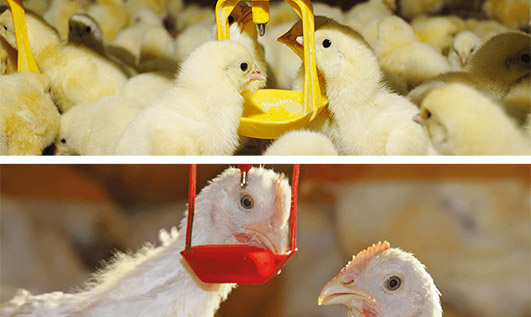
The above is the common equipment for intensive chicken farming introduced by automated chicken farming equipment manufacturers. If you have any related questions or are interested in our products, you can contact me:This email address is being protected from spambots. You need JavaScript enabled to view it.
Laying hen equipment manufacturers introduce technical measures for high-yield laying hens in summer
The ideal ambient temperature for laying hens is 15~25℃. Its production performance is good in this temperature range. If the house temperature is too high, the chicken must increase the number of breaths to dissipate body heat. As a result, the intake of food decreases, the amount of drinking water increases, and the intake of nutrients is insufficient. It will lead to a decrease in egg production, a smaller egg weight, an increase in egg broken rate, and loss of layer production. In order to maintain high yields for laying hens during the high temperature in summer. The laying hen equipment manufacturers recommend that farmers should strengthen feeding management and adopt effective comprehensive technical measures in light of local climate conditions.

Reduce the temperature of the chicken house and provide a suitable production environment. Suitable environmental temperature is one of the important conditions for high production of laying hens in summer. Generally, the following measures are taken to prevent heatstroke and cool down the effect:
(1) Plant trees or vines on the sunny side of the chicken house. Every spring, set up a pergola on the sunny side of the chicken battery cages, planting trees or plants such as loofah, grapes, winter gourd, etc., which can reduce radiant heat by more than 50%, and can also purify the air and reduce dust.
(2) Strengthen ventilation. Open doors and windows to increase the amount of air exchange. Ventilation equipment such as ceiling fans and exhaust fans can be used when the high temperature continues to promote heat dissipation from the chicken body and reduce the content of harmful gases in the air in the house.
(3) Spray water to cool down. In the continuous hot and sultry weather, spraying water on the chicken body or the roof of the chicken house intermittently can reduce the house temperature by 4 to 8°C.
(4) The water curtain cools down. You can also set a water curtain at the air inlet of the chicken house to cool the outside hot air before entering the chicken house. The general use time is from 10 am to 5 pm, which can reduce the house temperature by 3 to 6°C.
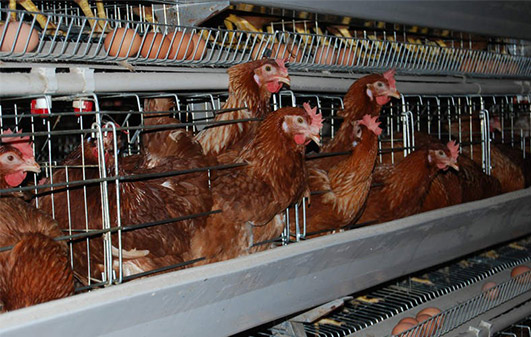
Strengthen feeding management
(1) Supply clean drinking water. In the hot season, the water intake of the laying hens is 5 times the feed intake. Therefore, it is necessary to ensure that each chicken can drink clean and cold water.
(2) Reduce the stocking density. In summer, when the flock density is too high, the temperature in the house will be higher, and the flocks are prone to pecking and heat exhaustion. Therefore, it is necessary to formulate a reasonable stocking density according to the actual situation.
(3) Reduce stress. Try not to change the feed as much as possible, without mildew and rancid feed. Fixed feeding management operating procedures, in terms of feeding, drinking, cleaning, disinfection, etc. It should be carried out regularly according to the procedures, and noise should be avoided during the operation. The adjustment of the flock should be carried out at night to prevent the chickens from being disturbed.
The above is the method of sharing high-yield chickens in poultry layer cages in summer. I hope that farmers can make full use of the above methods to better raise chickens and make chickens produce more eggs.
Drinking water skills for laying hens on automated chicken breeding equipment
When laying hens are raised by automatic chicken raising equipment. All aspects of management will directly affect the laying rate of laying hens. Water is the most important in the breeding process of laying hens. There must be drinking water suitable for the production of laying hens. How to provide drinking water for laying hens?
Farmers can observe the drinking water law of laying hens and change the drinking water temperature according to the seasons. During the breeding process, farmers should be good at discovering and summarizing. It can be known from daily observations. There will be three peak drinking times for the laying hens and chickens: 8 o'clock, 12 o'clock, and 6 o'clock in the afternoon. Therefore, at these three time points, farmers must ensure that the laying hens have sufficient drinking water. Like the hot weather in summer, farmers must provide cold water. This can speed up the heat dissipation in the laying hens and increase feed intake.

Farmers can pay attention to changing the amount of drinking water for laying hens. The water consumption of laying hens in different periods is different. Under normal circumstances, the water consumption of each chicken is about 200mm in spring and autumn, 110mm in winter, and 280mm in summer. However, as the egg production rate increases, the water requirement gradually increases.
Farmers should pay attention to the law when supplying water to the chicken coop. During the peak period of egg production, farmers should pay special attention to providing sufficient water for the chicken coop. Here, farmers can be advised to purchase automatic drinking water system equipment-drinking nipple. It can ensure that each chicken can drink enough clean water. It is also very conducive to ensuring the health of the chicken.
These are the skills chicken cages equipment manufacturers for farmers is about finishing equipment laying hens chickens, laying scientific water supply. The three points described in the article are the essential knowledge of layer breeding technology. Layer farmers must ensure that the laying hens have sufficient drinking water and health in feeding and management, so as to improve the laying rate and egg quality of the laying hens.
How to do a good job in the management of chicken coops in autumn
After the chicken has passed the hot summer. Physical fitness has declined. After autumn. The weather gradually became cooler. It is necessary to gradually increase the feed intake and egg production of the laying hens. At this time, strengthening feeding management is conducive to the recovery of laying hens. Improve the economic benefits of breeding laying hens.
In order to ensure higher egg production performance and better benefits for layer cages, the following measures need to be taken.
Adjust the flock. In autumn, old chickens begin to change feathers, and new chickens begin to lay eggs. This is a good season to adjust the flock. Farmers can adjust and appraise the chickens in a planned way. Leave chickens with good production performance, strong system and normal egg production.
Reduce the impact of climate change and add light. Farmers must ensure that the microclimate in the chicken coop does not change too much. Reduce the temperature difference between day and night. After the fall, the time of natural light is gradually shortened. During laying hens, light should be supplemented moderately. The most suitable temperature for laying hens is 13-24°C. The relative humidity is 50% to 75%. Too high and too low will reduce the egg production rate of the chicken.
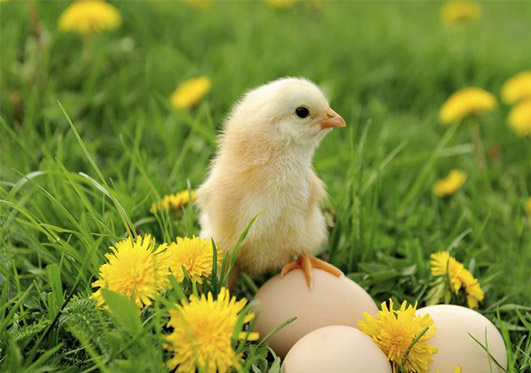
Do a good job in autumn epidemic prevention. In early autumn, there is a lot of rain and humidity, the weather is sultry, and the house is humid. Chickens are prone to respiratory and intestinal infectious diseases. Therefore, strengthening sanitation and epidemic prevention is another important link to ensure high and stable production of laying hens
Strengthen ventilation.
Open doors and windows during the day, increase ventilation, and properly ventilate at night to reduce temperature and humidity, which is conducive to the heat dissipation of the chicken body, reduces the water content in the chicken manure, and reduces the conditions for chicken manure digestion in the chicken house: Frequent cleaning, food troughs, water troughs and other utensils should be disinfected regularly to reduce the incidence of chicken diseases.
Vaccine prevention
Combined with autumn prevention, vaccinate chickens and get rid of internal parasites (especially roundworms and tapeworms). During the deworming of chickens, the feces of the chickens should be removed in time and accumulated and fermented to kill the eggs.
Observe frequently
Pay attention to the chicken's spirit, feeding, movement, defecation, etc., and isolate and treat sick chickens in time to prevent spread.

In order to better manage chicken flocks, farmers can purchase automatic chicken farming equipment to achieve intensive chicken breeding. Better management of chicken coops.
Methods for raising chickens in layer cages to prevent egg breakage
Farmers are in the daily process of raising chickens. There are some broken eggs caused by careless management. Eggs are affected by the health of the chicken, and the hardness of the eggshell will also vary due to the health and quality of the chicken flock. Here are some methods for farmers to prevent egg breakage.
After laying hens begin to lay eggs, they increase with age. The surface of the egg will also increase. The strength of the eggshell is reduced. Therefore, the older the laying age, the higher the breakage rate. In laying hen cages, the higher the egg breakage rate of standing or squatting laying hens is lower. Laying hens lying prone or squatting have lower egg breakage rates.
Laying hens lack the light required to absorb calcium at night, and the eggshells formed are thinner. Therefore, the breakage rate of eggs laid in the afternoon is lower than that of eggs laid in the morning. The health of the chicken also affects the quality of the eggs. Many diseases have an impact on the quality of eggshells. Such as infectious bronchitis, etc. will make the egg structure abnormal, irregular shape, and increase the egg breakage rate.

Among the nutrition, calcium, phosphorus and vitamin D have a greater impact on the quality of eggshells. Under normal circumstances, the amount of calcium required in the diet of laying hens should be 2.7-3.75%. This is 3-4 times larger than the 0.9% calcium requirement of non-laying hens. The phosphorus requirement of the laying hen's diet should be 0.5%. Vitamin D can promote the absorption of calcium and phosphorus. Such as in the absence of vitamin D. Even if the laying hens are fed rich calcium and phosphorus, they will produce soft-shelled eggs.
Environmental changes and the temperature of the chicken house have a greater impact on the eggshell. The higher the shelf temperature, the more broken the eggs. In summer, the eggshells of eggs laid by chickens are usually about 5% thinner than eggs in other seasons. This is mainly because high temperature will reduce the feed intake of chickens, and the intake of calcium will be reduced accordingly. In addition, in a high-temperature environment, if the relative humidity is high, the heat dissipation of the chicken is not good, and the egg will be damaged even more.
Farmers can purchase automated chicken raising equipment. It contains an automatic egg collection system. The chicken coop has a slightly inclined angle. After the laying hen lays the egg. The eggs roll along the conveyor belt. This reduces the egg breakage rate.
